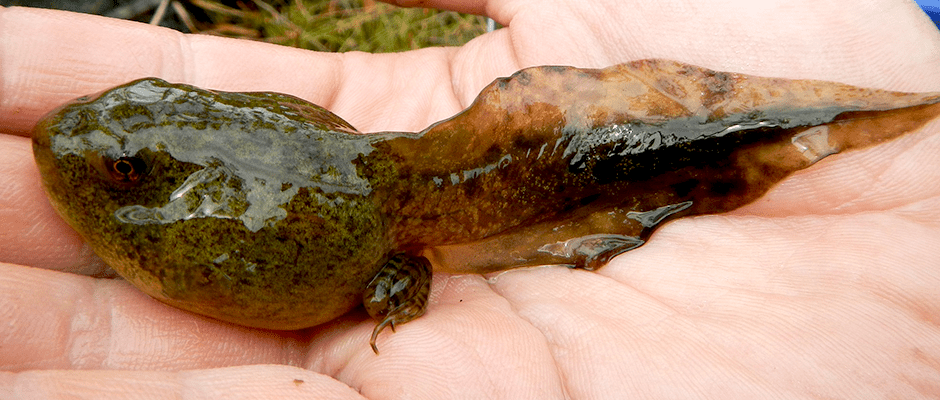Share this article
Changing rainfall patterns impact frogs and toads
When ephemeral wetlands swell with water, frogs and toads congregate to breed and lay their eggs, which hatch into tadpoles. “That’s risky business,” said U.S. Forest Service research ecologist Katie Greenberg. “Wetlands could dry before tadpoles metamorphose into juveniles.”
If ephemeral wetlands dry out before the tadpoles develop lungs and become froglets or toadlets, an entire cohort dies.
Despite the risks, ephemeral wetlands are also sanctuaries where hungry fish cannot encroach. Fish – and some aquatic insects – devour eggs and tadpoles. Eggs laid in fish-free waters have a much better chance of hatching into tadpoles and reaching metamorphosis.
Greenberg and her colleagues studied six frog and toad species that represented four reproductive strategies. “We wanted to see how rainfall, temperature and other environmental factors affect reproductive success,” Greenberg said. The scientists published their findings in the journal Ecosphere.
Reproductive success is influenced by the hydroregime – the season, frequency, depth and amount of time that water remains in wetlands.
“Ephemeral wetlands are highly dependent on weather patterns,” Greenberg said. “Changes to the amount or timing of rainfall could affect hydroregimes, and thereby the fate of innumerable tadpoles.”
Over the past century, seasonal patterns of rainfall have shifted. On average, summer rains have become less common, and fall rains have become more common. “The severity and patterns of storms are changing,” Greenberg said. “Average temperatures have also increased, especially in winter.”
The changes will not affect all species equally. Frogs and toads have various reproductive strategies. The species breed in different seasons, and their tadpoles vary in rates of development and the timing of metamorphosis. For example, eastern spadefoot toad tadpoles metamorphose into juveniles in as little as two weeks, while southern leopard frog and gopher frog tadpoles need several months or more. Transformation from tadpole to young frogs or toads is juvenile recruitment and is a way to measure reproductive success.
Greenberg and her colleagues used long-term data from eight ephemeral wetlands in the Ocala National Forest, Florida. The scientists have continuously tracked all of the amphibians and reptiles entering and exiting these wetlands for 22 years.
The results suggested that air temperature has minor effects – or no effect – on tadpoles of most species.
For five of the six species studied, reproductive success was highest when wetlands stayed inundated for the maximum amount of time tadpoles need to mature. The total amount of precipitation, plus at least one hydroregime variable, were also important factors for the five species, which include the southern toad, oak toad, eastern narrow-mouthed toad, southern leopard frog and the gopher frog, a species of conservation concern.
The gopher frog and the southern leopard frog have long breeding periods and slow larval growth. Their tadpoles also stay in wetlands until late spring, regardless of when the eggs were laid. “Having water continuously in the wetlands through spring metamorphosis is an important predictor of success for these frogs,” Greenberg said.
Rainy years were best for most species, but not the eastern spadefoot toad. Spadefoot toads breed explosively after heavy rains, such as those associated with tropical storms. The intense storms rapidly fill previously dry wetlands. However, heavy rains after breeding seemed to make it harder for the tadpoles to survive.
Reproductive success for eastern spadefoot toads was closely associated with the number of adult toads breeding.
Tadpole survival was also affected by unseen, seemingly random factors. For example, aquatic insects prey on eggs and tadpoles. Tadpoles are also competing with each other for food. “These factors can affect survival rates, but are very difficult to measure in the field,” said Greenberg. Maintaining multiple ephemeral wetlands that fill and dry at different times increases the odds of successful juvenile recruitment by diverse amphibian species with differing hydroregime requirements.
The study shows how environmental factors interact with reproductive strategies to influence tadpole survival to metamorphosis. Frogs and toads with shared reproductive strategies were influenced by similar factors.
“Species with similar reproductive strategies will likely be affected by climate change in similar ways,” Greenberg said. “The study has critical implications for future generations of frogs and toads. Changing weather patterns could influence amphibian populations – some species could become more common, and others could decline.”
This article was originally published by the U.S. Forest Service as a news release, which is available here. Click here to access the latest publications by Southern Research Station scientists. For more information, email Katie Greenberg at kgreenberg@fs.fed.us.
Header Image: A gopher frog tadpole metamorphoses into a juvenile frog. ©Florida Fish and Wildlife Commission








